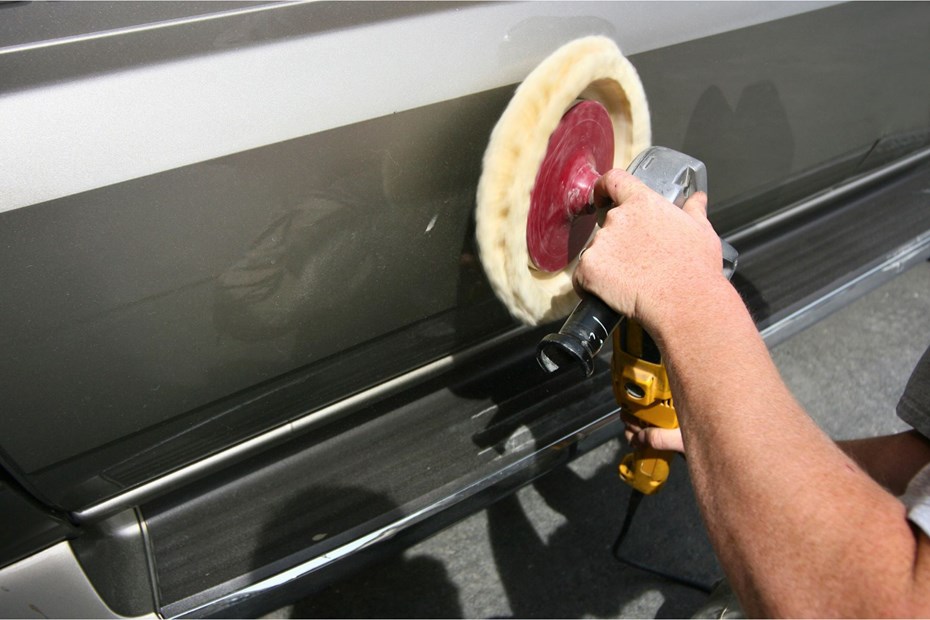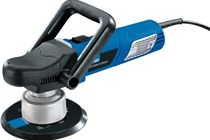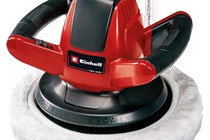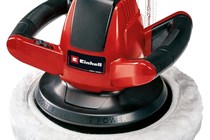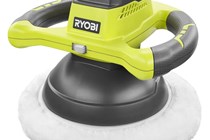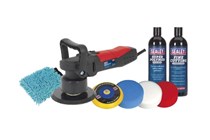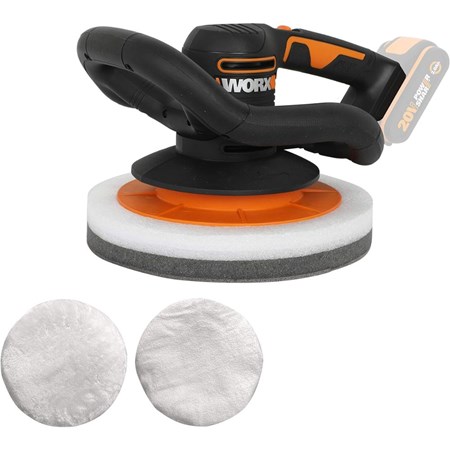Care of bodywork and paint protection might seem like a lot of work, but the results and satisfaction can make it well worth it. Like angle grinders or planers, car buffers and polishers can be daunting to those of us who are unfamiliar with them. But with a bit of practice, they are a faster, easier alternative to polishing your entire car by hand.
Polishing pads and machines are primarily used for buffing your paintwork and removing smaller imperfections. Small scratches, marks and swirls can all be dealt with using a polishing machine by applying a cutting compound or polish, which should then be coated in a protective layer, such as wax or paint sealant. Deeper scratches will need treating with the help of a professional.
In terms of dedicated car buffers, there are two types: rotary and dual-action polishers. A rotary polisher is a type typically used by professionals to restore bodywork and paintwork after panel beating. Like an angle grinder, a rotary polisher spins at a constant set speed. They’re very effective, but in the hands of a greenhorn, they can and do often cause damage to bodywork in the form of surface burns and buffer marks.
Dual-action polishers are a much easier type of car buffer for DIYers to use. Like a random orbital sander, they oscillate instead, kind of like a very fast hand-polishing movement. This movement creates less heat and, as such, they don’t run the risk of burning the bodywork as a rotary does. They are smaller and lighter, too, which makes them easier for newcomers to handle.
Best car buffer machines and polishers at a glance
Other car buffing tools that can be used for polishing are the aforementioned angle grinders and random orbital sanders with polishing pads fitted. Since angle grinders work like rotary polishers, we don’t recommend you use one for polishing unless you are familiar with doing so. However, random orbital sanders are wonderful and versatile tools that you can use beyond polishing. The oscillating movement makes them gentle and effective car paintwork, and their lightness makes for easy use.
The best car buffers and polishers
Best cordless polisher


The price shown is for the tool only, you will need to buy the ONE+ batteries and charger if you don’t have them already. The two-handed design gives you great control, and at 2.4kg, it’s easy to hold.
Pros
- Covers good surface area
- Not too heavy to hold
Cons
- No battery included
Best value dual action polisher
A big plus point with this Draper Storm Force® Dual Action Polisher is the five-metre cable. It also comes with a backing pad and storage bag.
Pros
- Ideal for beginners
- Lightweight to hold
Cons
- Cable may be too short for some
Best small polishing kit
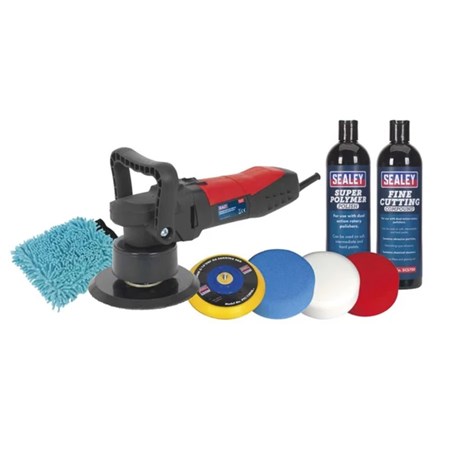

As for the bits and pieces, you get 500ml of a fine-cutting compound for dealing with minor scratches and marks; 500ml of high-gloss polish; dense, medium, and ultra-soft polishing pads; the backing pad to which they attach; and a microfibre mitt for finishing. Just make sure you protect your hard work with a wax coating or sealant.
Pros
- Comprehensive little kit
- Great for beginners
Cons
- Buffing surface area isn't as wide
Best quality machine buffer
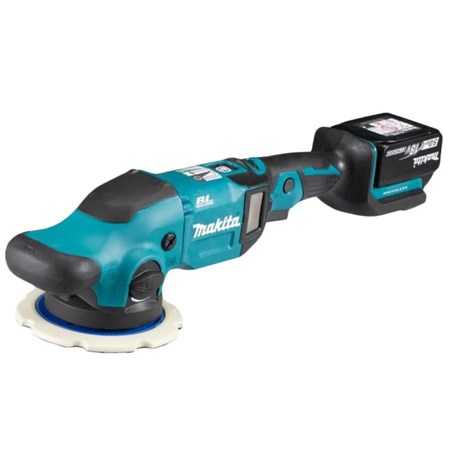

It has two random orbit modes; one standard mode, and one that has a forced rotation mode. This allows for both a fine and rough polishing style, depending on the job in hand. It also has a variable speed trigger which ranges from - to 5,200rpm in 'Finishing Mode' and 0 to 6,800rpm in 'Normal Mode'.
Pros
- Variable speed trigger
- Great quality tool
Cons
- Buffer attachment not included
Best for most comfortable buffer to use
It has what Worx call a 'rubber overmould' grip handle which has been designed to reduce vibrations during the polishing process. It's compatible with both of Worx's 18V and 20V batteries, but unfortunately, they aren't included in the basic purchase.
Pros
- Comfortable to use
- Can fit two different batteries
Cons
- Battery and charger not included
I can spin from 0 to 2,500rpm and has a polishing disc with a diameter of 25.4cm included. For covering surface area alone, this is a seriously good bet in the world of polishing buffers.
Pros
- Large polishing disc included
- Lightweight
Cons
- Battery and charger not included
Tips for using paint buffing tools
Clean and dry the car’s paint thoroughly. Then add a small amount of polish to the pad and add some polish to the area of paint to be polished. Set the machine on to its slow setting at first, then hold the pad gently against the paint and spread the polish around a bit. You can increase the speed thereafter once you’re in the rhythm. However, to get an even gloss and shine on the paintwork, the pressure and speed need to be consistent, so don’t rush.
You should also be progressing in small areas at a time. This helps you remember what you’ve covered and makes the job more organised. Remember to buff each section until a haze forms. Sometimes this requires more than one go. And don’t forget to turn off the machine before pulling the polisher away from the paintwork otherwise, polish may get flung everywhere. Lastly, remove the haze with a microfibre cloth.
FAQs
-
What buffer do professional detailers use?
Each detailer will have their own personal preferences, but most typically look for machines that offer a good balance of power, control, and durability, along with compatibility with various polishing pads and compounds.
-
What is the difference between a buffer and a polisher?
A buffer is primarily used for removing paint defects such as scratches, oxidation, and swirl marks. They can perform heavy correction work by abrading the paint surface. Polishers focus more on refining the paint surface and enhancing gloss after major defects have been corrected. Polishers use less aggressive pads and compounds compared to buffers.
-
Should you use a buffer on your car?
Using a buffer on your car can be useful for maintaining and restoring its paintwork, but it's important to understand the process and use the right tools and techniques to avoid damaging the paint.
-
Is it better to hand wax or use a buffer?
If you’re new to car detailing, hand waxing might be the safer and simpler option. It’s easy to learn and reduces the risk of damage to your car’s paint. If you have experience with buffers or are willing to learn, using a buffer can save time and provide superior results.
-
Do you polish or buff first?
Buffing tackles tougher paintwork faults and polishing refines the paintwork finish. So buff then polish.
-
Do buffers remove scratches?
Buffers can be used to remove scratches and other imperfections n your car's paintwork.
-
What are the disadvantages of buffing a car?
Buffing a car can risk paint damage, such as burning the paint or creating swirl marks, especially if done incorrectly. It also requires an investment in quality equipment and involves a period of learning.
-
Do I need a car buffer?
If you want to make your car sparkle and shine as much as the paintwork wants it to, then buffing and polishing your vehicle is by far the best option. You should consider how often you're going to be polishing and buffing your vehicle and, of course, the size of your car. If you've only a small vehicle, you may want to stick to some good quality buffing pads, but if you've got a larger car with big body panels, a buffing tool is a good option.
Sign up to the Parkers Newsletter to keep up to date with more of the latest reviews, news, and recommendations from the Parkers team.
Just so you know, we may receive a commission or other compensation from the links on this website - read why you should trust us.


